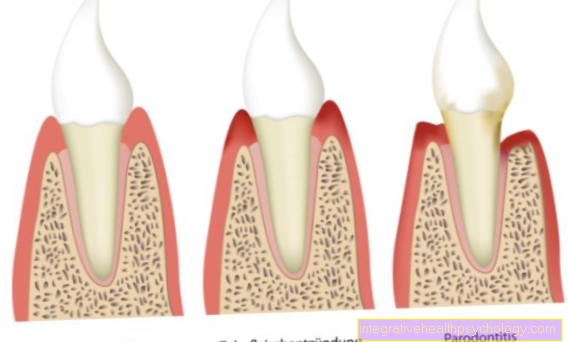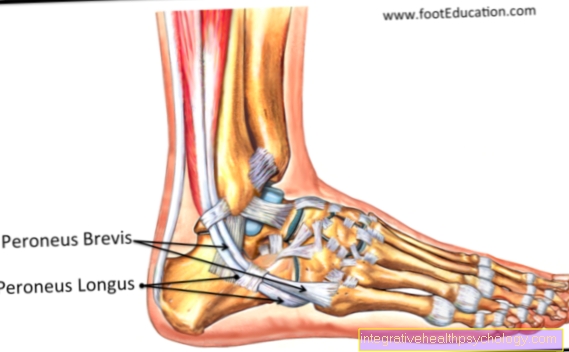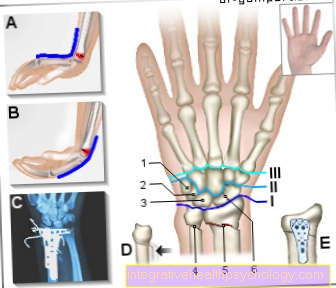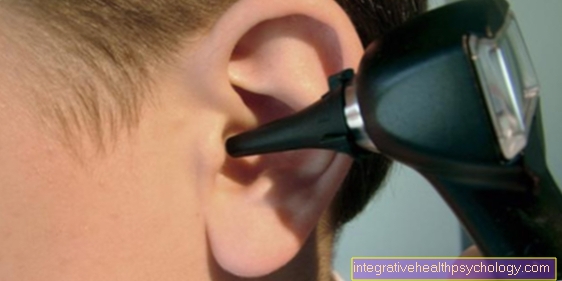Anisocoria
Definition - What is an anisocoria?
The anisocoria (anisos = unequal, koros = Pupil) describes a side difference in pupil size.
The pupils can be set differently depending on the strength of the incident light. In bright light, the pupil is made very narrow so that we are not blinded. In low light conditions, we need a wide pupil so that enough light falls on our retina and we can see an image.

Even if our eyes are illuminated at different levels of brightness, the body sets the pupils equally wide and orientates itself on the pupil that is illuminated more brightly. In addition, the size of the pupils is determined by the sphincter (Sphincter pupillae muscle) and the expansive muscle (Dilator pupillae muscle) influences.
If there is a disorder of the muscles, the nerve tracts responsible for the muscles or the perception of brightness, anisocoria can occur. Our pupils are then of different sizes.
also read: Different sized pupils
What are the possible causes of anisocoria?
The causes of anisocoria are many.
First of all, the unequal size of the pupils can be completely normal, because many people do not have completely identical pupils in their normal state. It can be assumed that around 20% of the healthy population has anisocoria.
A pathological anisocoria, on the other hand, is usually caused by a malfunction of the pupil muscles. The disorder is either in the brain, in the conductive nerve pathways or in the muscles themselves.
Typically anisocoria indicates an increase in pressure in the skull.This damages the conduction pathways and the brain, resulting in a malfunction of the pupil control. Anisocoria occurs in the case of a one-sided malfunction.
If both sides are no longer controlled, the pupils remain dilated even when light falls into the eyes.
Typical causes for such an increase in pressure in the skull can be
- Bleeding in the head or brain,
- a stroke,
- a traumatic brain injury or
- be a brain tumor.
Brain tumor as a trigger for anisocoria
In terms of its name, a brain tumor is basically a mass in the brain. This can be both benign and malignant and in both cases often manifests itself as increased intracranial pressure. Due to the mass, the brain needs more space, but its expansion is severely limited by the cranial bones, which means that the pressure increases instead.
This manifests itself, for example, when the nerve tracts in the skull no longer function reliably. The first sign of this can be pupils of different sizes (i.e. an anisocoria).
Find out more at: Signs of a tumor in the brain
Stroke as the cause of anisocoria
In the event of a stroke, a circulatory disorder in the cerebral vessels results in an insufficient supply of oxygen and other nutrients to the nervous tissue.
On the one hand, this can be triggered by an injury to the vessels and a resulting cerebral haemorrhage; on the other hand, a blockage of the vessels, for example by a blood clot (thrombus) or calcium deposits lead to a stroke.
Typically, a stroke causes the affected area to lose its brain function. The classic symptoms for this are
- sudden speech disorders
- a one-sided paralyzed facial expression or
- also the paralysis of an arm or a leg.
- The pupil function can be disturbed on one side, which leads to anisocoria.
Learn more at: This is how you recognize a stroke
Diagnosis of anisocoria
The diagnosis of anisocoria can be made through what is known as a visual diagnosis. So you do not need any technical investigations to determine an anisocoria.
In order to determine the extent of the disorder, a test with the pupil lamp is usually carried out. First of all, one eye is shone in the affected person, the pupils of both eyes should become smaller. The test is then carried out on the other eye. Depending on the location of the disorder (pathway from the eye to the brain or from the brain to the pupillary muscles), different reactions of the pupils occur.
Further diagnostics can be performed to determine the exact cause of the impaired pupillary function. Above all, the anamnesis plays a role, in which possible triggers of the anisocoria can be inquired about. Imaging of the skull may be required.
When do you need an MRI of the head for anisocoria?
An MRI of the head is needed if the cause of the anisocoria is in the brain. In the case of sudden pupillary disorders, one initially assumes an acute event such as a brain injury, bleeding or a stroke. In this case, a CT scan of the skull is done first, as this examination is much faster (a few minutes) than an MRI (20 to 30 minutes) and the time in the event of an acute danger plays an important role in the prognosis of the brain tissue.
If no acute problem can be suspected, an MRI of the head is usually performed. Small lesions (damage) such as bleeding or masses can also be detected. MRI is particularly suitable for searching for tumors, as this type of imaging can display brain tissue particularly well.
Accompanying symptoms in amisocoria
The accompanying symptoms in anisocoria are highly dependent on the cause of the symptoms.
Sudden processes such as bleeding or a stroke are often accompanied by acute disorders of other brain functions and are often expressed as an inability to move certain muscle groups (facial muscles, arm muscles, leg muscles, throat muscles = speech disorders). These malfunctions are usually one-sided, as the bleeding or the insufficient supply of the brain only takes place on one side.
In the case of slower processes, such as a brain tumor or increased intracranial pressure due to disturbances in the removal of cerebral fluid, no such acute symptoms occur. Instead, the accompanying symptoms gradually become noticeable. Often it comes first to
- recurring headaches.
- Visual disturbances,
- Dizziness,
- and vomiting can be triggered by the increased pressure in the skull.
Migraines and anisocoria
Migraine is a type of headache that occurs suddenly and is accompanied by other symptoms such as nausea or visual disturbances. The pain is usually in one half of the head, but can vary from migraine attack to migraine attack between the sides. It is not uncommon for so-called prodromes (signs) to occur before the onset of migraines. These manifest themselves in the form of mood swings, tiredness, difficulty concentrating, etc.
During the migraine attack, affected persons are often sensitive to smell, light and noise, and a so-called aura in the form of visual disturbances can also occur. In addition, individual functions can be disturbed, which can manifest itself in the form of tears, anisocoria, dizziness and vomiting.
Read on below: Circulatory disorder in the brain
Is therapy possible for anisocoria?
The therapy of anisocoria is very different depending on the underlying cause. A physiological (in a healthy state) anisocoria does not have to be treated.
If there is an acute cause such as bleeding or a stroke, immediate therapy is necessary. In the event of a stroke caused by a blood clot, this should be resolved with medication as soon as possible. Limescale deposits can be removed by an interventional procedure.
If there is a bleeding, the blood clotting should be brought to a normal level (it usually occurs in people who are treated with blood thinners). Most acute diseases that provoke anisocoria have increased pressure in the skull. A rapid reduction in intracranial pressure, for example with mannitol, is therefore necessary. In the case of very high intracranial pressure, relief can be made by opening the skull.
also read: Increased intracranial pressure - signs and therapy
Even slow processes such as a brain tumor can cause increased intracranial pressure and must therefore be treated. The therapy can take place by means of an operation or by radiation or chemotherapeutic agents. Which treatment is most suitable depends heavily on the type of brain tumor.
Occasionally, disorders of the pupil function are also triggered by poisoning or drugs. Therapy can also be carried out in these cases with suitable antidotes. If necessary, monitoring is sufficient until the body functions normalize.
Duration of anisocoria
How long an anisocoria lasts depends mainly on the therapy of the intracranial pressure. The pupil function usually improves with the normalization of the pressure in the skull. If there is direct damage to the brain region responsible for the pupils, the tissue can take a long time to recover.
In the event of poisoning or drug use, it usually takes a few hours, depending on the drug, for the effects to wear off. A physiological anisocoria usually lasts for a lifetime, but has no disease value.
Anisocoria in the baby
In most cases, anisocoria in babies is congenital and has no disease value; only in rare cases is there a disease or a pupillary disorder.
If you notice different pupil sizes in your child, you should first pay attention to whether other symptoms occur. If this is not the case, a physiological anisocoria can be assumed.
If you are still concerned, you can have the anisocoria clarified by the pediatrician. Usually an ultrasound of the head is done, if necessary an EEG (recording of the brain waves) can be written. An ophthalmologist can also be called in if an eye disorder is suspected.
If the anisocoria occurs suddenly and especially together with other symptoms such as
- severe restlessness or
- Apathy,
- Fever,
- Slackness,
- Drinking weakness, etc.
on, this can be an indication of a sudden happening in the brain. Immediate clarification of the complaints at the pediatrician or in the clinic makes sense in these cases. Especially if the symptoms are preceded by a triggering situation such as a fall on the head, you should go to a clinic as soon as possible.
You might also be interested in: Everything to do with babies - symptoms & diseases
Recommendations from the editorial team
These topics could also be of interest to you:
- Dilated pupil
- Different sized pupils
- Pupillary reflex
- Symptoms of a cerebral hemorrhage
- Signs of a stroke





























